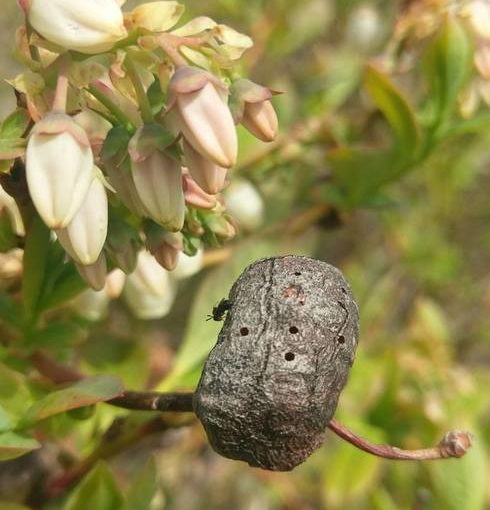May 21, 2019Preparing for gall wasp emergence in Michigan blueberry fields
The Michigan Enviroweather model predicts blueberry gall wasp emergence starting later this week.
Blueberry gall wasp is a small insect pest that affects some of the cultivars common in Michigan, with the greatest infestation seen in Jersey and Liberty cultivars. Infestation is also geographically restricted, with higher pressure from this pest seen in the northern regions of Michigan blueberry production. This article summarizes what we have learned in recent years about controlling gall wasp and provides recommendations on the currently available options that can help minimize infestation.
Blueberry stem gall wasp has one generation a year in Michigan, and its development is driven by temperature. Emergence of the wasps usually coincides with bloom of J ersey bushes. There is a degree-day model for blueberry gall wasp on Michigan State University’s Enviroweather website. This predicts 5% emergence in Lawrence on May 22 compared with South Haven on May 25 (Van Buren County), reflecting the lake effect on degree-day accumulation in southwest Michigan. Further north in Fennville and in West Olive, early emergence is predicted on May 25.
ersey bushes. There is a degree-day model for blueberry gall wasp on Michigan State University’s Enviroweather website. This predicts 5% emergence in Lawrence on May 22 compared with South Haven on May 25 (Van Buren County), reflecting the lake effect on degree-day accumulation in southwest Michigan. Further north in Fennville and in West Olive, early emergence is predicted on May 25.
With the warm temperatures expected this week, we expect widespread wasp emergence continuing through blueberry bloom. Another way to predict emergence is to carefully cut open the galls and look to see if the larvae have turned black. Once they are black with red eyes, emergence is not far behind.
During activity of the wasps, the females lay eggs into the young shoots. They are particularly attracted to rapidly growing shoots, so we are currently exploring whether delayed nitrogen fertilizer applications can help reduce gall sizes. There are few insecticides that can be used during bloom because of bee safety concerns, and the Bts (Dipel, Javelin, etc.) and Intrepid or Confirm used for fruitworm control around this time are not active on these wasps.
The one insecticide registered for use during bloom with activity on the wasps (from our lab studies) is Sivanto, though multiple growers did not find good performance with it last season. The label allows for two applications at 14 ounces per acre, but they must be done a week or more apart and we do not see residual activity long enough to maintain protection for a full week. So, this seems to be a weak option for controlling this pest. Do not tank-mix this product with azole (FRAC 3) fungicides. When using this product, the applications should be made with high water volume to ensure excellent coverage.
Once honey bees are removed from the fields, there are many more options for controlling gall wasps. Lannate and Mustang Maxx are two particularly effective insecticides against this pest, providing very effective knockdown of the wasps and some penetration into the tissues to reduce egg and larval development. Growers using high gallonage (75-100 GPA) to apply Lannate right after bloom followed one week later with the pyrethroid insecticide (Mustang Maxx, Asana or Bifenthrin) have managed to keep wasp populations from getting worse in fields of Liberty that are also managed with regular winter pruning and destroying of the galls. These applications also need to be done with a high volume of water. It is much harder to control this pest in fields of Jersey that have very high densities of galls, and in these sites a combination of tactics is essential to prevent the galls from developing.
– Rufus Isaacs, Philip Fanning and Steve Van Timmeren, Michigan State University, Department of Entomology
A gall showing multiple emergence holes, with a newly emerged gall wasp perched on the left of the gall. Photo: Rufus Isaacs, Michigan State University.














